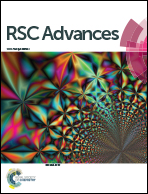Cytotoxicity effects of three-dimensional graphene in NIH-3T3 fibroblasts
Abstract
The 3D configuration of graphene materials has been intensively investigated due to their novel properties in biomedical, electrical and optical applications. But few reports have been intentionally carried out to understand the biological influence of 3D graphene materials so far. Herein, we presented an evaluation of the in vitro cytotoxicity of 3D graphene sheets fabricated by carbonization of polydopamine (PDA) films on a template of aligned nanopore arrays (NPAs) on a stainless steel surface. The prepared 3D graphene sheets with a thickness of ∼20 nm displayed a nanoporous architecture that can be readily tuned by the NPA template to control the morphology of the 3D configuration. The in vitro toxicity of the nanoporous 3D graphene sheets with pore sizes of ∼50 nm and ∼240 nm was evaluated using NIH-3T3 fibroblasts as the representative mammal fibroblast cell type. The NPA structure exhibits enhanced properties in cell attachment, spreading, proliferation, and the assembly of focal adhesions and actin filament associated proteins. Morphology-dependent cytotoxicity aroused by the 3D graphene configuration should be attributed to the engulfment of the carbon nanospheres embedded in the 3D configuration and the lack of both focal adhesions and actin filament associated proteins assembling at the nanoscale.


 Please wait while we load your content...
Please wait while we load your content...